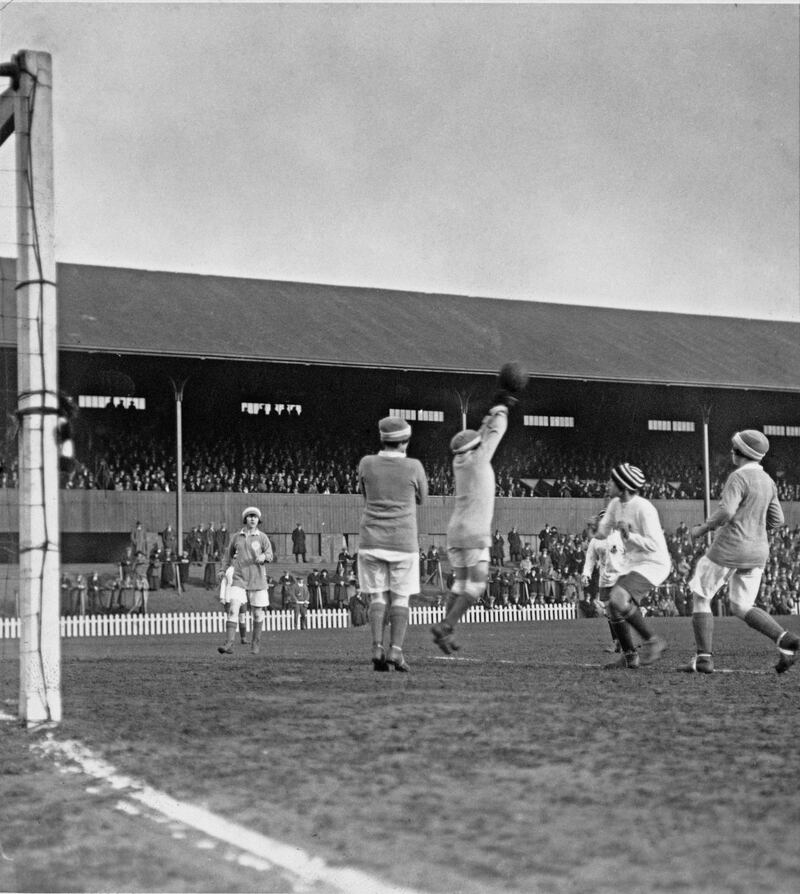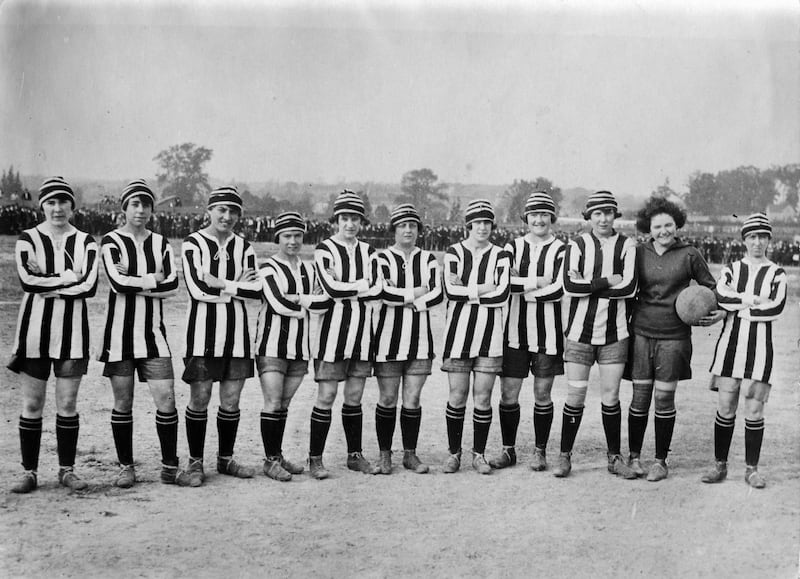Despite women having been turfed out of the workplaces in large numbers and the return of men’s football after its suspension between 1915 and 1919, the women’s game was thriving at the turn of the 1920s, with the Dick, Kerr Ladies – a famous factory team from Preston – at the forefront.
In 1920, the team would play four international home fixtures against a French team led by the women’s sport advocate Alice Milliat at Deepdale, Stockport, in Manchester and then Stamford Bridge. The team then headed to France and played in Paris, Roubaix, Le Havre and Rouen. It would prove to be a hugely popular tour and on the team’s return to England, the hype for a scheduled Boxing Day match against rivals St Helens at Goodison Park was building. Few, though, could have predicted the seismic impact the fixture would have on the future of women’s football.
On the day of the match 53,000 fans would file into the ground for the game with, according to the diary of the player Alice Stanley, a further 10–15,000 supporters turned away from the at-capacity ground. It set an attendance record that would not be surpassed for 92 years – until Team GB beat Brazil at Wembley during the London 2012 Olympics in front of 70,584 – and remains the biggest domestic game in women’s football in England, with the 38,262 who watched Arsenal defeat Tottenham at the new Tottenham Hotspur Stadium on 17 November 2019 at number two.
It reportedly broke another record too, with the Lancashire Evening Post on 28th December 1920 saying: “The most remarkable ‘gate’ of the holiday, however, was at Goodison Park yesterday morning [Boxing Day] where the Dick, Kerr Ladies beat St Helens ladies 4–0 in a match on behalf of the unemployed and disabled ex-service men. The attendance was estimated at 53,000 and the receipts were over £3,000 exclusive of tickets. This being an easy record for a charity match in England.”
The money raised that day was the equivalent of about £140,000 today. This focused the minds of those watching the Dick, Kerr Ladies and other women’s teams with mistrust and trepidation. It would be this hugely successful match that would trigger the devastation of the women’s game.
The FA and the political establishment were not blind to the growing popularity and success of women’s football. The huge sums of money being raised were outside their jurisdiction and control. Worse still, that money was no longer being raised to support the war wounded but was being channelled into political and working-class causes – causes antithetical to the establishment.
So, one year after more than 53,000 spectators turned out to watch at Goodison Park, the FA voted to ban women’s football. The sport’s governing body did not have the power to ban women from playing outright – that was impossible, so instead they ruled that women’s games were barred from FA-affiliated football grounds. The ban was to last for 51 years.
The FA’s Consultative Committee’s ruling stated: “Complaints having been made as to football being played by women, council felt impelled to express the strong opinion that the game of football is quite unsuitable for females and should not be encouraged. Complaints have also been made as to the conditions under which some of the matches have been arranged and played, and the appropriation of receipts to other than charitable objects. The council are further of the opinion that an excessive proportion of the receipts are absorbed in expenses and an inadequate percentage devoted to charitable objects.
“For these reasons the council requests the clubs belonging to the association refuse the use of their grounds for such matches.”
This was not the first time the FA had attempted to place restrictions on the game. In the 1890s, the FA council sent warnings to clubs about the use of their grounds for ladies’ matches. In 1902, the FA passed a motion that banned mixed-sex games, but there is also some evidence pointing to this ban having extended to women’s teams’ use of FA-affiliated grounds too. There are references that imply it was still in place as far back as 1917.

The presence of such 1902 restrictions would perhaps offer an explanation for the tailing off of the game after popularity in the late 19th century.
Regardless of whether the ban in 1902 similarly denied the use of FA-affiliated grounds, it did not stop the resurgence of women’s football during the first world war and it is almost impossible to believe this increased visibility, culminating in the 53,000 spectators at Goodison, did not act as a significant contributing factor to the new ban of 1921.
Gail Newsham, the author of a book on the Dick, Kerr Ladies, believes the record-breaking Boxing Day match, which followed games watched by more than 35,000 at Old Trafford and 25,000 at Deepdale, was instrumental.
“The Goodison match would have sent a seismic shock throughout the football world, because so many people went to that match. We must remember that in 1920 they had expanded the men’s leagues – there was a new Division Three, North and South – so they had practically doubled the amount of clubs and all these people are going to watch women’s football as opposed to men’s football. There was going to be a conflict at some stage, wasn’t there?
“The Goodison match acted as a wake-up call. The FA then started stepping in to make it more difficult for clubs to let the grounds to women’s teams. Teams and clubs had to supply statements of accounts after every game and they couldn’t play without permission from the FA. They were putting obstacles in the way throughout 1921. Then came 5th December, when they dealt the fatal blow and banned them from playing.”
The players were furious. “When I spoke to Alice Norris [one of the Dick, Kerr players of the time] and some of the other ladies they all said they thought the FA was just jealous because they were getting bigger crowds,” Newsham says. “They were devastated. Everybody knows how much work the women did during the war, all the hard work, the manual jobs, everything that they did, so it didn’t stack up.”
Reports of the ban were mixed. On one side, the Hull Daily Mail delighted in the ban and praised the FA.
“It is an excellent thing that the Football Association has considered the question of women playing football. The ‘FA’ is really a sort of Venetian oligarchy in the best sense of the word. It is ‘a pyramid of Soviets’ – again in the best sense of the word; and we make bold to say that its rule and governance of its great game is a pattern and an example to all legislative bodies, parliament not excepted. This council is so wise that its decisions are respected universally, and its prestige so high that disobedience never enters the minds of its associates and followers.
“It can bind and loose, make or mar, suppress or exalt, and it controls not only the game, the clubs, the officials, and the players, but the crowd, too – and even the crowd fears it. This august body has decreed that women’s football is undesirable. It is a game ‘not fitted for females’. It discourages its clubs offering or selling the use of their grounds. It deplores the fact that in some cases so large a share of the ‘gate’ receipts have gone in ‘expenses’. All this is a pretty big mouthful for women’s clubs and the public to be going on with! We are not in the least enamoured of women’s football.”
Others gave space for the players to have their say. The Dick, Kerr Ladies’ captain, Alice Kell, described in the press as an “unassuming, intelligent working girl”, said: “We girls play football in a proper spirit. We do not retaliate if we are bowled over, and we show no fits of temper. We are all simply amazed at the action of the authorities in placing a ban upon the sport we love with all our heart. Surely to goodness we have the right to play any game we think fit without interference from the Football Association! We are all working girls dependent upon our weekly wages and living with our parents and others partly dependent upon us.”
There were also dissenting voices in the FA council meeting that would choose to implement a ban. One came in the form of a statement read to the committee by Major Cecil Kent from Liverpool, a former honorary secretary of Old Westminsters FC. Kent said he had attended about 30 women’s football matches and pointed out that the women’s game had contributed £100,000 to charity in two years.
“On all hands I have heard nothing but praise for the good work the girls are doing and the high standard of their play,” he said. “The only thing I now hear from the man is the street is ‘why has the FA got their knife into girls’ football?’ What have the girls done except to raise large sums for charity and to play the game? Are their feet heavier on the turf than the men’s feet?”

While the Dick, Kerr Ladies played on far beyond the ban, as did others, such as Heys from Bradford and Huddersfield Atalanta, the effect of the ban was devastating because it extinguished crowd sizes in an instant. Teams were forced into parks and friendly rugby or athletics clubs, but the stadium capacity offered by men’s football clubs could not be matched. Without the opportunity for the masses to watch games regularly in large-capacity venues the interest naturally waned.
“What drives me mad is the injustice of it,” says Newsham. “Imagine saying to Kelly Smith, or Megan Rapinoe, or any of the players today: ‘That’s it, you’re not playing any more, you’re banned. Nobody’s going to remember it, whatever you’ve done, it doesn’t matter, nobody is going to care or remember.’ Imagine that. You can’t imagine how they would feel, can you? But that’s what happened to them.”
This is an edited extract from A Woman’s Game by Suzanne Wrack: The Rise, Fall, and Rise Again of Women’s Football published by Guardian Faber on June 16th















